Porto-North-Portugal.com
The best independent guide to Porto
Porto-North-Portugal.com
The best independent guide to Porto
48 Hours in Porto: A Two-Day Suggested Itinerary for 2025
Two days is the ideal amount of time to discover Porto, allowing for a fantastic introduction to a city known for its rich history and vibrant contemporary culture. A 48-hour visit provides the perfect opportunity to explore the maze-like streets of its riverside districts, sample the famous Port wine, and enjoy its excellent culinary scene.
For most first-time visitors, a two-day trip is structured as a comprehensive tour of the city’s iconic sights. This classic approach focuses on the UNESCO-listed historic centre, with visits to landmarks such as the São Bento Station, the Sé Cathedral, and the Clérigos Tower, along with an essential tour of a Port cellar in Vila Nova de Gaia.
Alternatively, for those who prefer a more relaxed pace or are returning to the city, two days can be spent immersing yourself in specific neighbourhoods and experiences. This could involve dedicating more time to the riverside Ribeira district, exploring the modern art at the Serralves museum, or enjoying the coastal atmosphere and beaches of the Foz district.
This guide will provide a detailed suggested itinerary for your two-day visit, designed to help you make the most of your 48 hours in this remarkable city.
An overview for two days in Porto
Day 1 morning: Discover the grand plazas and impressive sights of the Cordoaria and Baixa neighbourhoods, which contain the Igreja do Carmo, Livraria Lello bookshop and the grand Câmara Municipal
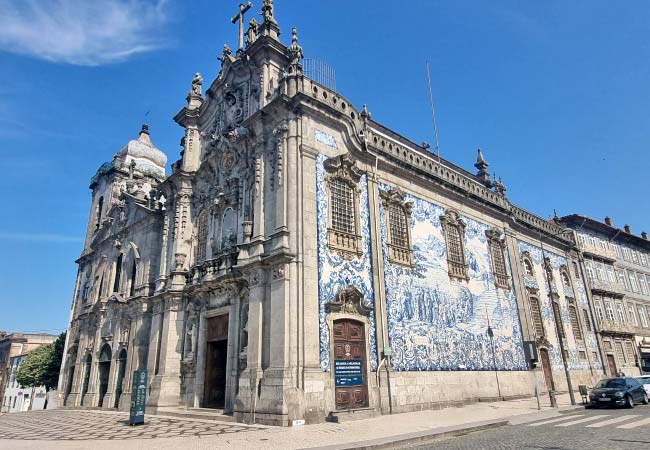
The beautiful azulejo tilework on the Igreja do Carmo church
Day 1 afternoon: Explore the historic heart of Porto by exploring the labyrinthine alleyways of the Ribeira and Sé neighbourhoods. Marvel at the iconic Sé Cathedral and wander along the pretty waterfront of the Ribeira neighbourhood
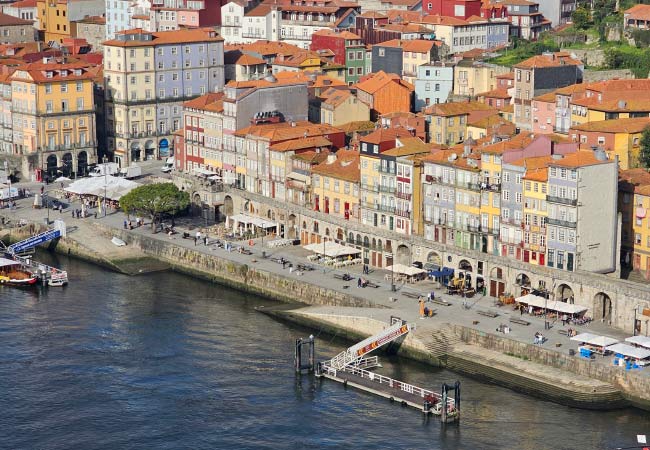
The colourful houses of the Ribeira lining the banks of the Douro River.
Day 1 Evening: Cross the Ponte Luís I bridge and watch the sunset from the Jardim do Morro, before having dinner in one of the restaurants on the Ribeira waterfront. To continue the night, head to the sociable bars around the Rua da Galeria de Paris.
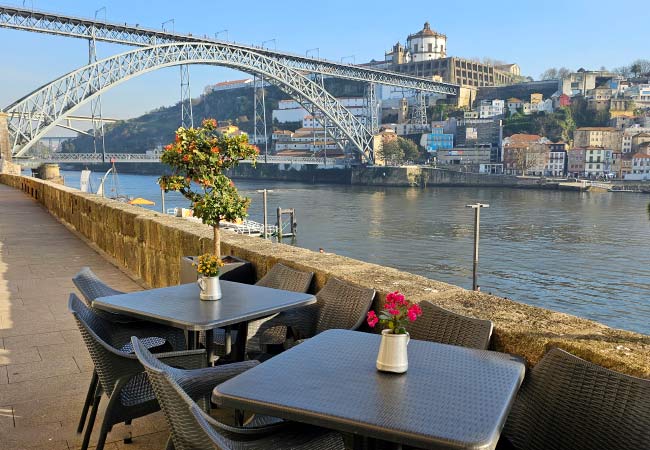
A romantic meal overlooking the Ponte Luís I bridge.
Day 2 morning: Visit Vila Nova de Gaia, the city on the southern bank of the Douro River, famous for its port wine cellars. Join a guided tour through one of the historic port cellars, followed by a short boat tour along the river.
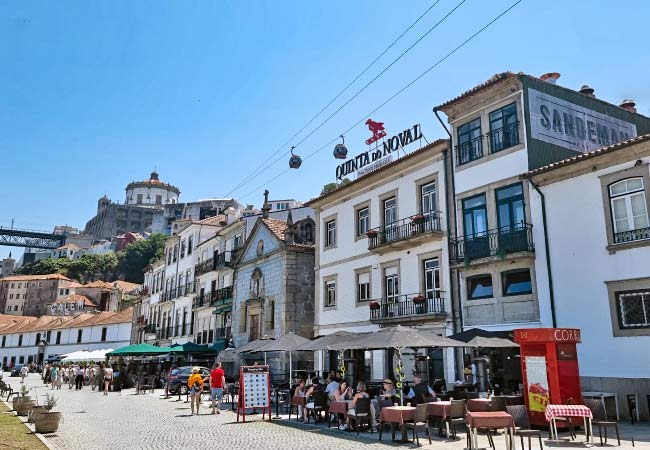
The Port cellars, historic buildings and cable car of Vila Nova de Gaia’s waterfront.
Day 2 afternoon: Ride the delightful tram to the Foz district and stroll along the waterfront promenade. End the day watching the sunset from one of the beach bars that overlook the Atlantic Ocean.
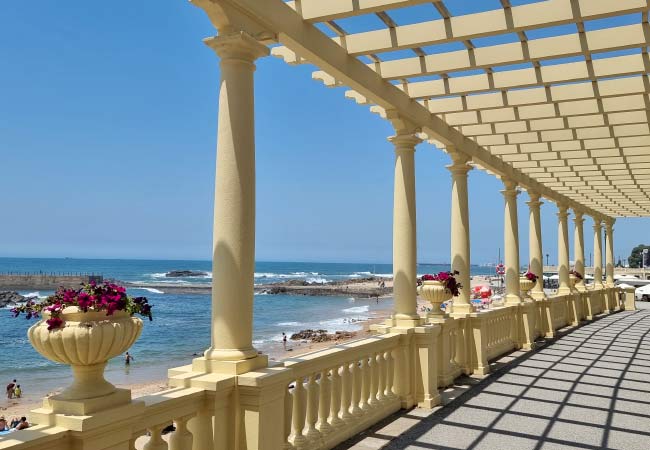
The Pérgola da Foz, overlooking the Praia do Molhe beach and the Atlantic Ocean.
Day 2 afternoon (alternative 2): Have a cultural afternoon visiting the Soares dos Reis National Museum, combined with a walk through the nearby Palácio de Cristal gardens.
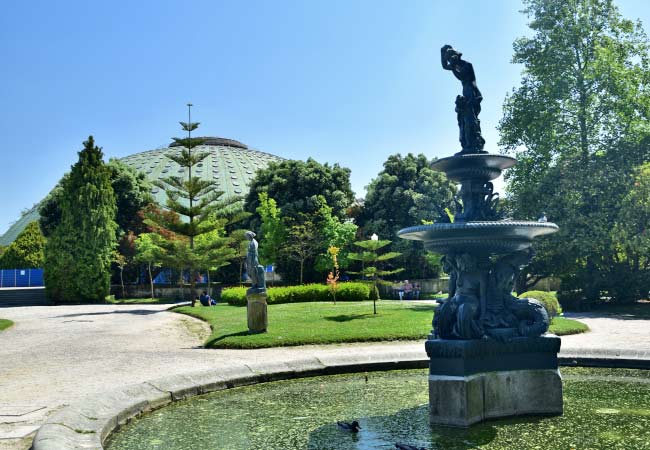
The interactive map below shows the highlights of this two-day tour of Porto and includes a walking tour for each of the days. (Note: zoom out to see all of the points)
Day1 (green) 1) São Bento Train Station 2) Sé Cathedral 3) Ribeira neighbourhood 4) Igreja de São Francisco 5) Palácio da Bolsa 6) Rua das Flores 7) Torre dos Clérigos 8) Igreja do Carmo 9) Livraria Lello 10) Avenida dos Aliados 11) Ponte Luís I bridge 12) Jardim do Morro viewpoint
Day 2 morning (yellow) 13) Caves Cálem 14) Caves Sandeman 15) Caves Ferreira 16) Half Rabbit (art) 17) WOW Porto
Day 2 afternoon (blue) 18) Jardim do Passeio Alegre 19) Forte de São João Baptista 20) Pérgola da Foz 21) Mercado do Bolhão 22) Mercado Bom Sucesso 23) Museu de Arte Contemporânea de Serralves 24) Museum Soares dos Reis 25) Palácio de Cristal gardens 26) Dragão Stadium (FC Porto)
Useful guides for your two days in Porto
The following are links to our specific guides, which may be of further use to you:
A walking tour of Porto (for your first day in Porto)
Which port cellar in Vila Nova de Gaia should you visit? (for your second day)
A tour of the Foz district (for your second day)
Porto’s best beaches (for your second day and in the summer)
Have you booked your hotel yet?
There is very high demand for accommodation during the peak season, so we’d advise that you book your hotel rooms now before they sell out. To check current prices and availability, enter your holiday dates in the search box below:
Day 1 Morning: The Grand Avenues of Baixa and Cordoaria
The first morning is best spent exploring Baixa and the adjacent Cordoaria district, which together form the grand civic and commercial heart of Porto. As the city's monumental centre, the area is characterised by wide avenues, expansive plazas, and impressive early 20th-century architecture.
A natural starting point is the Avenida dos Aliados, Porto's magnificent central boulevard. This grand sloping avenue is flanked by ornate granite buildings and is crowned at its northern end by the imposing Câmara Municipal do Porto (City Hall). Leading off from this area is Rua de Santa Catarina, the city's primary shopping street, where you can also find the historic Café Majestic. It is worth visiting for its opulent Belle Époque interior of carved wood, mirrors, and chandeliers.
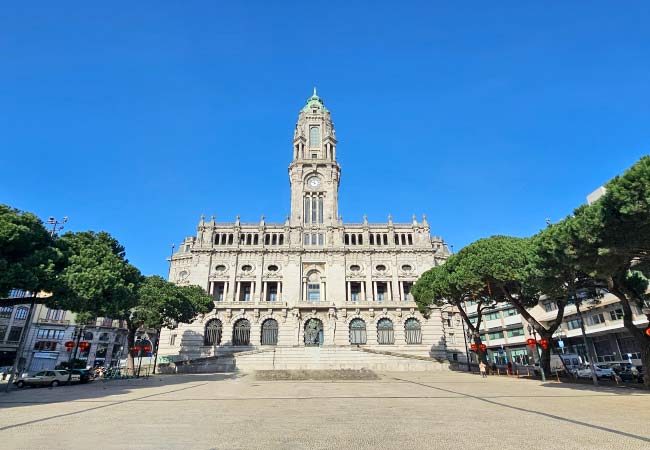
Porto City hall dates from the 1920s but the Neo-gothic styling makes it appear much older
A short walk west brings you to a cluster of Porto's most famous landmarks. The Torre dos Clérigos, a Baroque bell tower, is the definitive symbol of the city's skyline; a climb to its summit is rewarded with commanding panoramic views. Nearby is the Igreja do Carmo, renowned for the vast blue-and-white azulejo tile panel that covers its entire side facade. This area is also home to the Livraria Lello, a bookshop famed for its magical neo-Gothic interior and elaborate staircase. Due to its immense popularity, entry requires a pre-booked ticket.
Further south, you will find São Bento Railway Station, which is much more than a transport hub. Its main hall is a gallery of art, with walls covered in approximately 20,000 azulejo tiles that depict scenes from the history of Portugal. From the station, the pedestrianised Rua das Flores offers a delightful path down towards the riverfront. This charming street is lined with traditional jewellers, independent shops, and cafes. It is also where you can find the Museu da Misericórdia do Porto (MMIPO), home to the significant 15th-century painting, "Fons Vitae".
The morning's exploration can conclude with lunch. For a truly local experience, this is an opportunity to try a Francesinha, Porto’s signature dish. This substantial sandwich is filled with several types of meat, covered in melted cheese, and served in a rich beer-and-tomato-based sauce.

The much-photographed Igreja do Carmo is covered with detailed tile paintings
Day 1 Afternoon: The Historic Districts of Sé and Ribeira
The afternoon offers a deep dive into the city's oldest neighbourhoods: the hilltop Sé and the waterfront Ribeira. Together, these two districts form the historic core of Porto, a UNESCO World Heritage site that presents a powerful contrast between the city's solemn origins and its lively commercial heart.
The Sé district, clustered around the city's imposing cathedral, is Porto's ancient religious and defensive centre. The Sé do Porto itself is a magnificent, fortress-like cathedral dating back to the 12th century. Its powerful Romanesque exterior contrasts with a more ornate interior, which includes a grand silver altarpiece and a Gothic cloister decorated with azulejo tiles. The large terrace in front of the cathedral offers one of the finest viewpoints in Porto. A short walk from here reveals the Igreja de Santa Clara, a church whose plain facade hides a breathtaking interior of extravagant, gilded woodwork (talha dourada). Throughout the district, you can also find remnants of the Muralha Fernandina, the 14th-century medieval city walls.
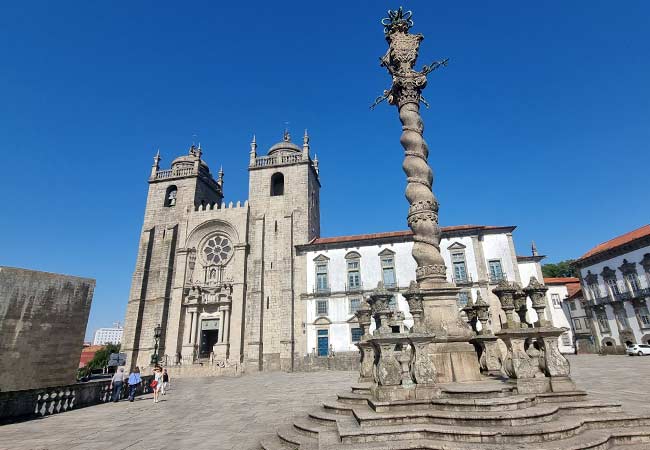
Down at the river's edge lies the Ribeira district, the vibrant and colourful soul of Porto. As the historic centre of river trade, its warren of narrow alleys and colourful, tall houses is instantly recognisable. The heart of the district is the Praça da Ribeira, a lively and picturesque square on the water's edge, filled with restaurants and cafes.
The Ribeira is also home to two of Porto's most spectacular buildings, located next to each other:
• Igreja de São Francisco: This church has a relatively plain Gothic exterior that gives no hint of the astonishing wealth within. Its interior is a masterpiece of Baroque artistry, with almost every surface covered in intricate and lavishly gilded wood carvings.
• Palácio da Bolsa: The 19th-century former stock exchange is a monument to the city's commercial power. A guided tour is required to see its magnificent interior, which includes the glass-domed Hall of Nations (Pátio das Nações) and culminates in the extraordinary Arab Room (Salão Árabe), an opulent hall decorated in a rich Moorish Revival style.
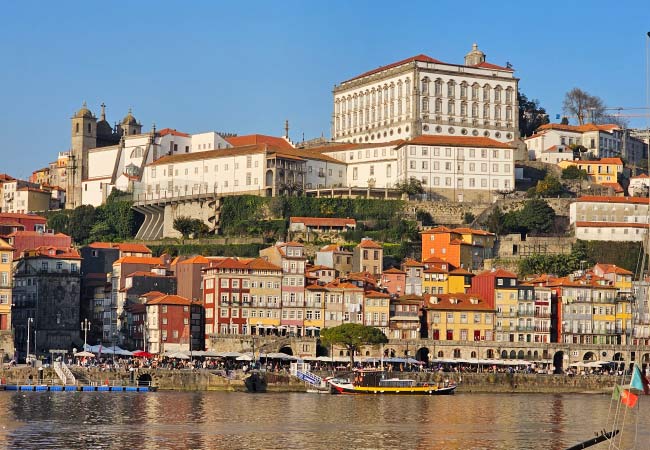
Evening Option: The Six Bridges River Cruise
An evening boat cruise on the Douro offers a relaxing and entirely different perspective on Porto's dramatic cityscape. From the vantage point of the water, the steep, terraced hillsides of both Porto and Vila Nova de Gaia rise up, revealing the true scale of the city.
The tour is known as the "Six Bridges Cruise" for its route passing beneath the structures that connect the two cities. You will sail under the impressive concrete arch of the Ponte da Arrábida near the river's mouth, see the intricate ironwork of the Ponte Maria Pia (a project from Gustave Eiffel's company), and pass beneath the city's most iconic structure, the two-tiered Ponte de Dom Luís I.
Tours typically last around 50 minutes and depart regularly from the quaysides in both Ribeira and Vila Nova de Gaia. Booking in advance is recommended, particularly for cruises timed to coincide with the sunset, as these are popular throughout the high season from June to September.
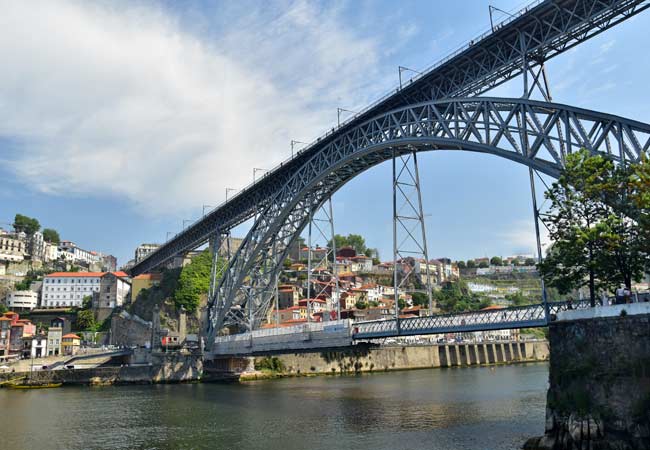
Day 2 Morning: Vila Nova de Gaia and the Port Lodges
The second day begins with a visit across the river to Vila Nova de Gaia. Although technically a separate city, Gaia's identity is inseparable from Porto's, as it is the historic home of the world-famous Port wine trade. The focal point of any visit is the bustling waterfront promenade, Avenida de Diogo Leite, which offers spectacular views back towards the colourful Ribeira district. The quayside is lined with the iconic flat-bottomed Barcos Rabelos, the traditional boats once used to transport barrels of wine down the river.
The Port Lodge Experience
The main reason to visit Gaia is to tour one of the historic Port lodges. These are not vineyards, but vast cellars (or caves) where the wine, produced much further up the Douro Valley, is brought to be blended, matured, and aged. For centuries, the barrels were transported down the Douro River on the Barcos Rabelos to these lodges, whose names adorn the rooftops along the hillside.
Nearly all of the famous Port producers, such as Graham's, Taylor's, Sandeman, and Cálem, are located here and offer guided tours. A typical tour explains the history of Port wine, the unique production process, and the story of the specific house, culminating in a tutored tasting of several different styles of Port. Tours are conducted in multiple languages throughout the day, but booking in advance is highly recommended, especially for the most popular producers or during the high season.

WOW: A Modern Cultural District
Set slightly higher up the hill from the main waterfront is WOW (World of Wine), a vast cultural and gastronomic district developed from beautifully restored Port wine cellars. Rather than a single attraction, WOW is a collection of seven distinct museum experiences, numerous restaurants, cafes, and shops. The main exhibits include The Wine Experience, which covers the entire process of winemaking, Planet Cork, dedicated to Portugal's vital cork industry, and The Chocolate Story.
Beyond the Port Lodges
While Port is the main attraction, Gaia's waterfront offers other points of interest. Tucked away on a side street, you can find the Half-Rabbit, a striking piece of urban art by the Portuguese artist Bordalo II, cleverly constructed from recycled materials.
For the best views, take the Teleférico de Gaia, a cable car that glides from the lower waterfront up the steep escarpment. The journey itself provides a fantastic perspective of the river and city. The cable car's upper station is located next to the Mosteiro da Serra do Pilar, a 16th-century monastery with a unique circular church. Its large terrace offers what is arguably the single most breathtaking panoramic view of the Ponte Luís I bridge and the entire historic cityscape of Porto.
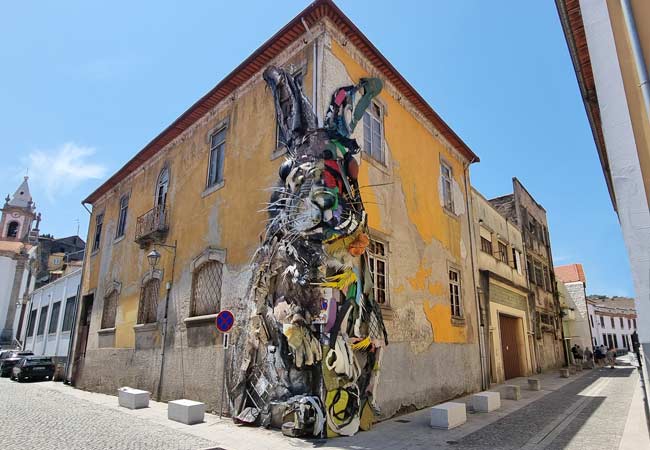
The “Half-Rabbit” urban art is one of the more unique sights in Vila Nova de Gaia
Day 2 Afternoon: Two Alternative Itineraries
For the afternoon of the second day, two excellent and contrasting options present themselves: a visit to the coastal Foz district, or an exploration of the gardens and museums surrounding the Palácio de Cristal.
Afternoon Option 1: The Coastal Foz District
The Foz district, located where the Douro River meets the Atlantic Ocean, offers a complete change of scenery from Porto’s historic centre. It is an affluent residential area known for its ocean promenades, small beaches, and a more relaxed pace. The district has two main areas of interest: the final stretch of the riverfront and the open Atlantic coastline.
Along the river, the Jardim do Passeio Alegre is a pleasant, shaded garden and a good starting point. The area features grand villas and is the terminus for the historic No. 1 tram line. From the garden, a path leads past the 16th-century Fortaleza de São João da Foz, a fortress that once guarded the entrance to the Douro.
The district's most famous feature is its Atlantic promenade. Here you will find the Pérgola da Foz, a classic colonnade from the 1930s that has become one of the city's most recognisable landmarks. The coastline itself is a mix of small, sandy coves like Praia do Molhe and rocky headlands, popular with local fishermen. The long promenade, which extends north towards the town of Matosinhos, is lined with numerous cafes and bars, making it an ideal location to watch the sunset over the ocean.
Getting There: The Foz district is best reached by the historic No. 1 tram, which offers a scenic journey along the river from the Infante stop near the Igreja de São Francisco. Alternatively, the 500 bus provides a faster and more frequent service from the city centre.
Related articles: The Foz district
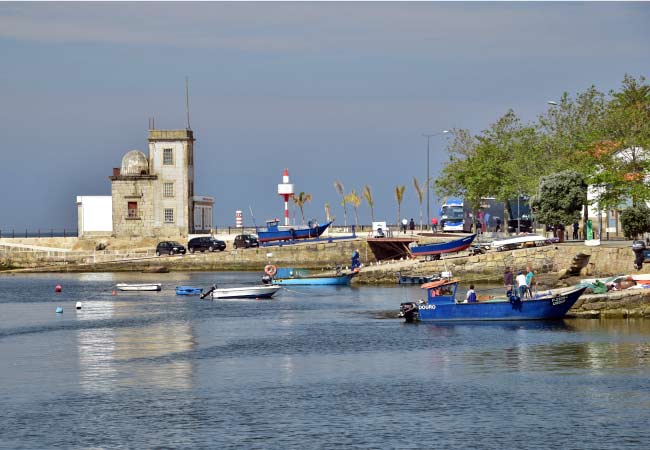
The little fishing harbours along the calm Douro River as it leaves the city

The Pergola da Foz is one of Porto’s most romantic places to watch the sunset
Afternoon Option 2: The Palácio de Cristal Gardens and Museum Quarter
For a more cultural afternoon, the area around the Palácio de Cristal offers a combination of art, history, and one of the city's best public parks.
The Jardins do Palácio de Cristal are the main attraction. These extensive, terraced gardens are set on a granite hill and offer some of the most commanding panoramic views across the Douro River, the Arrábida Bridge, and Vila Nova de Gaia. The gardens themselves are a mix of themed sections, including a rose garden and an aromatic garden, connected by tree-lined avenues where peacocks roam freely. The park gets its name from a 19th-century iron-and-glass exhibition hall that no longer exists; a large, modern domed pavilion (the Super Bock Arena) now stands in its place.
Adjacent to the park are two significant museums:
• Museu Nacional Soares dos Reis: Housed in the elegant, neoclassical Carrancas Palace, this is Portugal's first national museum. Its extensive collection is focused on Portuguese art from the 16th to the 20th centuries, with a particular strength in 19th-century painting and sculpture, including works by its namesake, António Soares dos Reis.
• Museu Romântico da Quinta da Macieirinha: This museum offers a preserved look into the life of Porto’s affluent 19th-century bourgeoisie. The house is furnished as it would have been during the Romantic period and is famous for being the final residence of the exiled King of Sardinia, Carlo Alberto, who died here in 1849. It provides a detailed view of the era's decorative arts and lifestyle.
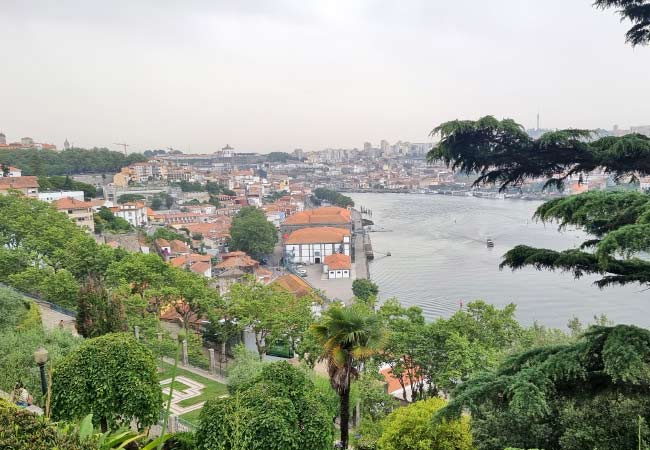
The view over Porto from the Jardins do Palácio de Cristal
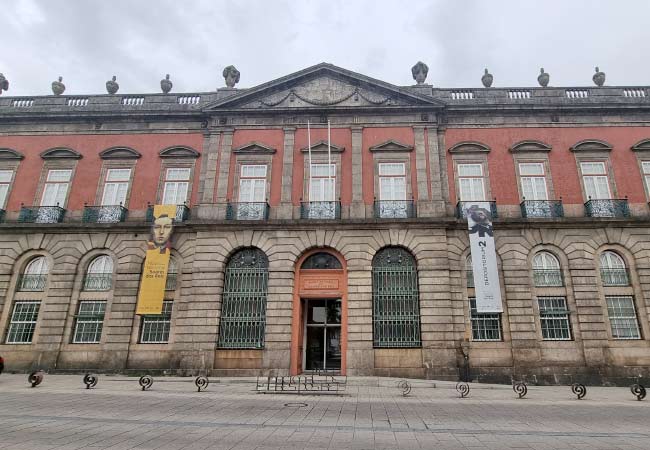
The Museu Nacional Soares dos Reis
Day 2 Evening: Nightlife in the Galerias District
For a memorable final evening, the bars and clubs of the Galerias district offer the city's most concentrated and energetic nightlife. The area is centred on Rua da Galeria de Paris and the parallel Rua de Cândido dos Reis, located a short walk from the university. This district is known for its wide variety of venues, which range from sophisticated cocktail bars to traditional pubs and places offering live music.
If you've enjoyed our content, we'd like to ask for your support.
The internet landscape has changed, and small independent publishers like us face increasing challenges. Search engines now prioritize advertising over organic content, reducing our traffic, while AI systems increasingly copy our original work without attribution.
To help support us, please consider bookmarking our website for easy access. If you find an article useful, we encourage you to share it with friends or on social media. Equally, if you notice anything outdated or incorrect, please let us know so we can promptly address it.
We're always open to collaborating with brands, bloggers, and SEO/PR agencies who value independent creators. If you'd like to work with us or offer support, please reach out at: [email protected]
Thank you for being part of our community and helping us continue to provide valuable content in an increasingly challenging digital environment.
























